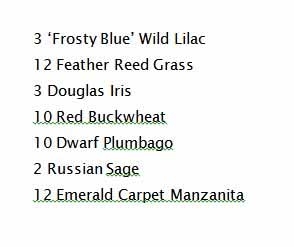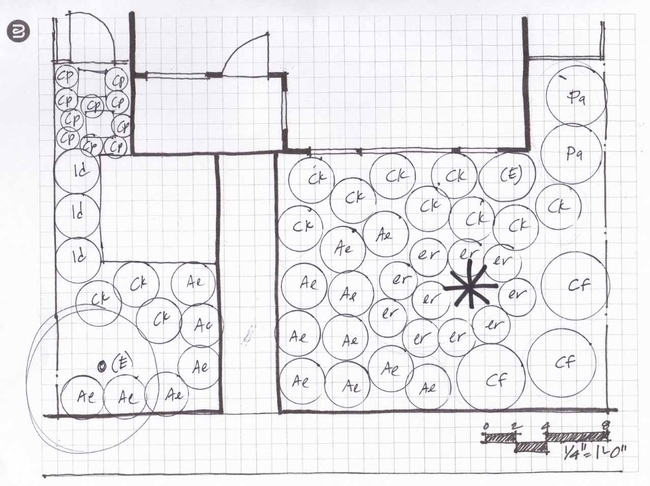Welcome to this special interval in our series on Planting Design Basics. Before diving into our final installment, “Is my yard ready to plant?,” let's explore how to develop an appropriate list of plants for your newly designed yard.
The preliminary planting plan that you've created after reading Part Three of this series will be your guide. It should reflect your responses to the following questions: What can I give my plants? What garden style do I want? and What plant “jobs” need to be filled in my garden? Your plan should show separate bubbles for each intended plant mass, labeled with plant job, cultural requirements, foliage type (evergreen or deciduous) and plant attributes. Your plant list will reflect these criteria.
On a fresh sheet of paper, list the descriptive information for each plant mass, leaving space between each entry to add candidate plant species.
For example, suppose your preliminary planting plan has identified the following plant jobs with descriptions for cultural requirements and attributes:
- Screen plants at north corner: Structure, evergreen, full sun, 5 to 7 feet, medium texture, rounded form.
- Screen at patio: Structure, evergreen, morning sun, 3 to 4 feet, fine or bold texture, vertical form.
- Accent at focal point: Filler, seasonal changes, full sun, less than 2 feet, medium texture.
- Groundcover at step stones: Filler, seasonal changes, shade, less than 12 inches, medium or bold texture.
- Ground cover near sidewalk: Filler, evergreen, morning to full sun, less than 12 inches, medium texture, uniform.
Brainstorm ideas for actual plants that support your chosen garden style while providing the desired characteristics. To help with this daunting task, resources are available to guide you. Brent McGhie, a Butte County Master Gardener, has put together Climate Appropriate Plants for the Northern California Landscape, a list which describes many of the needed attributes for each plant. It can be found here: http://ucanr.edu/sites/bcmg/files/237354.pdf. Another useful reference is The Butte County All-Stars found on our website.
Other excellent resources that focus on resource-conserving home gardening include: Sunset Western Garden Book; California Native Plants for the Garden by Bornstein, Fross, & O'Brien; and California Bees and Blooms: A Guide for Gardeners and Naturalists by Frankie, Thorp, Coville and Ertter.
As you find suitable plants, enter them into the appropriate spot on your list. To help you get started, here are sample plant lists for different garden styles keyed to the preliminary planting plan described above. (The plants listed here have not been sorted by color palette).
Screen plants at north corner: Structure, evergreen, full sun, 5-7 ft, medium texture, rounded form
- Naturalistic Native California Garden Style: Ceanothus ‘Frosty Blue' (wild lilac); Arctostaphylos ‘Howard McMinn' (McMinn manzanita)
- Mediterranean Garden Style: Cistus (rockrose); Myrtus communis (myrtle)
- Mid-Century Modern Garden Style: Miscanthus sinensis ‘Gracillimus' (maiden grass)
Screen at patio: Structure, evergreen, morning sun, 3-4 ft, fine or bold texture, vertical form
- Native CA: Muhlenbergia rigens (deer grass); Festuca californica (CA fescue)
- Mediterranean: Calamagrostis ‘Karl Foerster' (feather reed grass); Juniperus communis ‘Compressa' (dwarf fastigiate juniper)
- Modern: Chondropetalum tectorum (small cape rush); Phormium ‘Tom Thumb' (New Zealand flax)
Accent at focal point: Filler, seasonal changes, full sun, < 2 ft, medium texture
- Native CA: Eriogonum grande rubescens (red buckwheat); Salvia ‘Bee's Bliss (bee's bliss sage); Epilobium canum ‘John Bixby' (CA fuchsia)
- Mediterranean: Dianthus ‘Tiny Rubies' (dwarf carnation); Arctostaphylos uva-ursi (bear berry)
- Modern: Dymondia margaretae (silver carpet), Gazania rigens (gazania)
Groundcover at step stones: Filler, seasonal changes, shade, < 12 inches, medium or bold texture
- Native CA: Salvia Spathacea (hummingbird sage); Heuchera rosada (alumroot)
- Mediterranean: Teucrium chamaedrys ‘Prostrata' (dwarf germander);
- Modern: Ophiopogon ‘Nigrescens' (black mondo grass), Liriope ‘Silvery Sunproof' (variegated lily turf)
Ground cover near sidewalk: Filler, evergreen, morning sun, < 12 inches, medium or bold texture, uniform
- Native CA: Arctostaphylos ‘Emerald Carpet' (Emerald Carpet Manzanita), Festuca ‘Siskiyou Blue' (blue Idaho fescue)
- Mediterranean: Rosmarinus ‘Blue Boy' (Dwarf Rosemary), Origanum ‘Betty Rollins' (dwarf oregano)
- Modern: Artemisia ‘Silver Brocade' (wormwood); Cerastium tomentosa (snow in summer)

In our upcoming series finale, we will explore our fourth and final question: Is my yard ready to plant?
Happy Gardening!
This four part (plus bonus!) series of Real Dirt articles summarizes the presentation Butte County Master Gardener Eve Werner created for the Butte County Master Gardeners Spring 2017 Workshop Series. For more information about the Butte County Master Gardener
